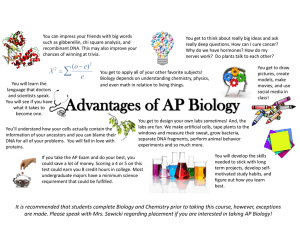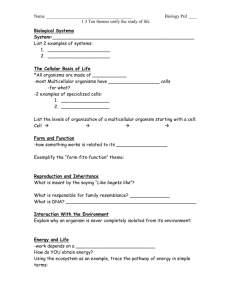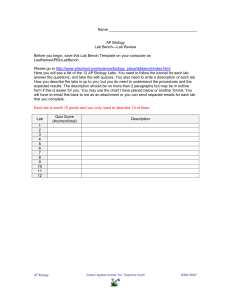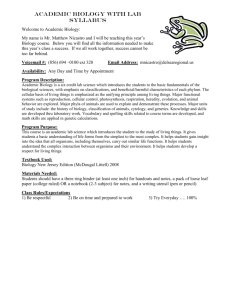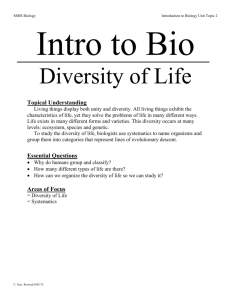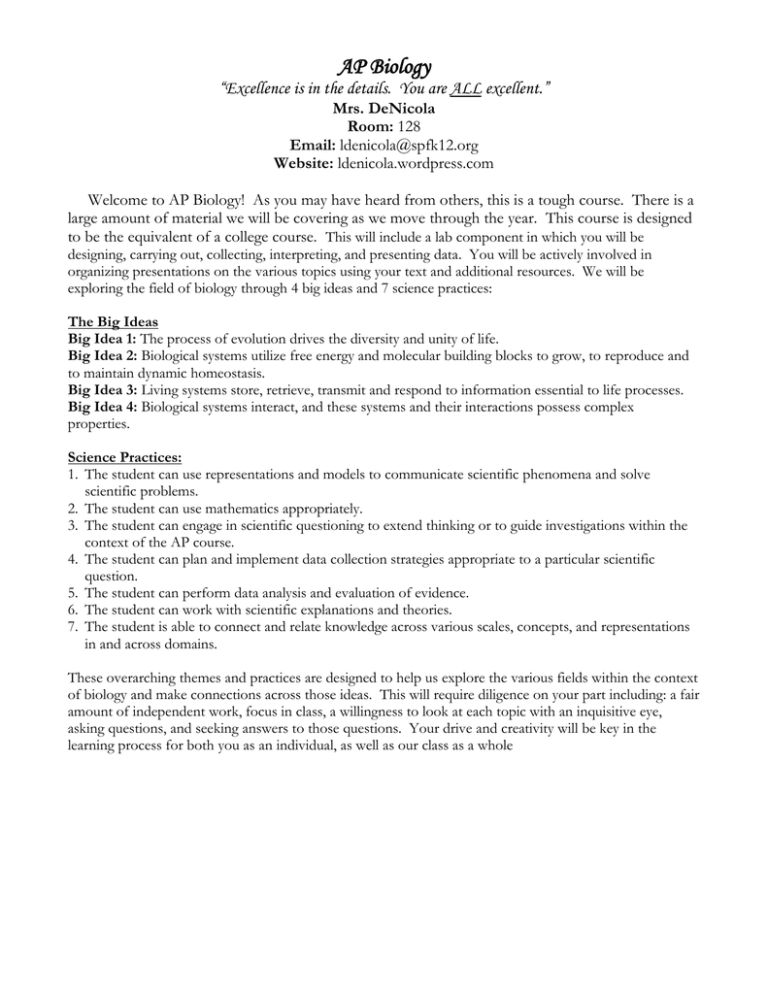
AP Biology
“Excellence is in the details. You are ALL excellent.”
Mrs. DeNicola
Room: 128
Email: ldenicola@spfk12.org
Website: ldenicola.wordpress.com
Welcome to AP Biology! As you may have heard from others, this is a tough course. There is a
large amount of material we will be covering as we move through the year. This course is designed
to be the equivalent of a college course. This will include a lab component in which you will be
designing, carrying out, collecting, interpreting, and presenting data. You will be actively involved in
organizing presentations on the various topics using your text and additional resources. We will be
exploring the field of biology through 4 big ideas and 7 science practices:
The Big Ideas
Big Idea 1: The process of evolution drives the diversity and unity of life.
Big Idea 2: Biological systems utilize free energy and molecular building blocks to grow, to reproduce and
to maintain dynamic homeostasis.
Big Idea 3: Living systems store, retrieve, transmit and respond to information essential to life processes.
Big Idea 4: Biological systems interact, and these systems and their interactions possess complex
properties.
Science Practices:
1. The student can use representations and models to communicate scientific phenomena and solve
scientific problems.
2. The student can use mathematics appropriately.
3. The student can engage in scientific questioning to extend thinking or to guide investigations within the
context of the AP course.
4. The student can plan and implement data collection strategies appropriate to a particular scientific
question.
5. The student can perform data analysis and evaluation of evidence.
6. The student can work with scientific explanations and theories.
7. The student is able to connect and relate knowledge across various scales, concepts, and representations
in and across domains.
These overarching themes and practices are designed to help us explore the various fields within the context
of biology and make connections across those ideas. This will require diligence on your part including: a fair
amount of independent work, focus in class, a willingness to look at each topic with an inquisitive eye,
asking questions, and seeking answers to those questions. Your drive and creativity will be key in the
learning process for both you as an individual, as well as our class as a whole
Classroom Expectations
Be on time and prepared every day
Be respectful of your classmates, your teacher, and yourself
Participate, participate, participate: there are NO stupid questions, we are here to share and
learn together
Be RESPONSIBLE!
Your work is your own, cheating and plagiarism will NOT be tolerated
The use of ANY electronics (i.e. cell phones, mp3 players, etc) is NOT allowed, unless you are
give specific permission.
Absolutely NO food or drink in the Science classroom
Notebook Policy
For this class you will be expected to keep a notebook solely for Biology. The type of notebook
you choose is completely up to you. It may be spiral, marble, 3-ring binder, etc. However, you will
need a separate section to keep as a biology glossary where you will define key terms as we learn
them.
You will be provided a lab notebook and you will be required to keep all of your lab notes in this
notebook. Raw data may be spot collected during a lab.
Grading Policy
Your grade in this class will consist of several different components. These are:
Participation (TBD) – During in-class assignments, participation points will often be given.
If you work efficiently and well with your partners, you will receive full credit. If you choose
to spend your class time not doing what you are supposed to, you will not receive credit for
that day’s work.
Homework/Labs (10 – 60 pts per assignment)
Quizzes (20 – 30 pts per quiz)
Projects (TBD based on depth of project)
Tests (60 – 100 pts each)
Your actual average will be calculated as a total number of points earned out of the total
possible. Extra credit will not be given if asked for, but it may be assigned at random.
You will be responsible for making up ALL missed work. You will have the equivalent amount of
time absent to make up work. It is your job to determine a time with me to come make up
tests/quizzes or presentations. If you do not do so, your grade will result in a ZERO. Absences
due to field trips DO NOT count as absences from school. If you are missing class due to another
function and an assignment is due, you must turn your work the day it is due either to me or in my
mailbox. Failure to do so will result in a late grade.
Text:
Freeman, Scott. Biological Science. 2nd Edition, Pearson Prentice Hall, Saddle River, NJ
2005.
ISBN 0-13-140941-7 (Hardcover)
Burggren, Warren, et. al. Study Guide for Biological Science. 2nd Edition, Pearson Prentice Hall, Saddle River, NJ
2005.
ISBN 0-13-109028-3
Additional Resources:
Allan, Richard, Senior Biology 1 2007, Student Resource and Activity Manual,
BIOZONE, International, Ltd. 2005
Allan, Richard, Senior Biology 2 2007, Student Resource and Activity Manual,
BIOZONE, International, Ltd. 2005
Online Labs available at: www.labbench.com
Biology II Course Proficiencies
Level: Advanced Placement 320
Course Description:
Prerequisites: Biology I, Chemistry I (accelerated level OR lower with teacher recommendation)
The Advanced Placement Biology course is designed to be the equivalent of a college
introductory biology course. Students are expected to carry out significant assignments with
responsibilities from the textbook, laboratory manual, and teacher prepared materials for support.
The AP Biology examination is constructed to meet the goals set for three general areas: molecules
and cells, genetics and evolution, and organisms and populations. While students may voluntarily
elect to take the AP examination, and are encouraged to do so, it is not mandatory. Students must
be prepared to begin class at 7:41am everyday and continue through until the end of period 1.
Course Proficiencies:
The following is a list of skills and concepts students will be proficient in upon successful completion of this
course. These proficiencies, derived from the College Board's AP Biology curriculum, form the basis of
assessment of each student's achievement. Students will be able to:
1. Apply science as a process of inquiry. (5.1/12 A-C; 5.3/12 A-D)
2. Explain how evolution is the unifying principle of all biology. (5.5/12 B)
3. Model energy transfer mechanisms from molecules to populations. (5.5/12 A1-3; 5.6/12 A6)
4. Explain genetic continuity and change from generation to generation. (5.5/12 C1-2)
5. Understand the complementarity of structure to function. (5.5/12 A)
6. Explain a variety of regulatory mechanisms. (5.5/12 A; 5.6/12 B)
7. Discuss the interdependences found in nature. (5.8/12 C2-3; 5.10/12 A&B)
8. Demonstrate an understanding of the implications of advances in science & technology to society.
(5.2/12 A&B; 5.4/12 A&B; 5.5/12 C3; 5.10/12 B2)
9. Effectively use technological tools/applications to assist in the collecting, analyzing/interpreting, and
conveying of data and information. (8.1A-B , 8.2)
Assessment:
A variety of evaluation tools will be used to determine student achievement in this course. Any or all of the
following tools will be used:
a. Tests and quizzes.
b. Laboratory performance, reports, and journals.
c. Class participation.
d. Well-developed homework.
e. Technology-based activities.
f. Projects, including oral presentations.
g. Self or peer assessment.
h. Teacher observation.
Anticipated Course Outline:
Unit 1: Introduction, Science as a Process, and Ecology
(9 classes; extended observation for AP Lab #10)
Big Ideas: 1, 2, 4
Science as a Process & Ecology Discussion Topics
o Observation, question formation, and inquiry based investigations
o Student summer experiment presentations
o Interactive review of ecological concepts learned through summer assignment
Activities/Labs
o AP® Biology Lab #12 - Animal Behavior-The goal is to investigate behavior and an
organism’s response to environmental conditions. Students will observe general behaviors to
determine whether an observed behavior is taxis, kinesis, or learned, as well as observing
habitat selection. Students will then generate their own investigations based on questions
they have from their observations. This lab will allow for present and future discussions
regarding the effects of changes in the environment and the role of variation and adaptations
in the success of organisms.
o AP® Biology Lab #10 – Energy Dynamics – The goal is for students to understand the
flow of energy through ecosystems as it is converted from solar energy to chemical energy in
plants (primary productivity) and then further transferred from organism to organism (as
calculated using biomass). Students will build mini-ecosystems between Brussels sprouts and
cabbage white butterflies to observe interactions and calculate inputs and outputs of energy
in the system. This will allow for students to raise their own questions regarding organism
interactions and the ways in which energy flow is determined, providing students with the
opportunity to investigate and create their own models of energy flow. This will present
students with the importance of energy flow and provide the foundation for further
discussions regarding the cellular mechanisms involved in the process(es) and the effect of
disruptions to energy flow.
Unit 2: Evolution
Big Ideas: 1, 3, 4
Evolution Discussion Topics
o Darwin and the Theory of Natural Selection
o Biochemical evidence for evolution (DNA, RNA, protein)
o Geologic evidence for evolution (plate tectonics, fossils)
o Physiological evidence for evolution (mimicry, homologous/analogous structures,
embryology)
o Mechanisms of evolution (mutation, genetic drift, variation)
Activities/Labs
o AP Lab #1 – Artificial Selection – This lab will serve as a continuation of student work
with Fast Plants from AP Lab #10 as students look at specific physical features observed in
these plants. Based on their questions about the role of these features, students will
artificially select for a specific trait and investigate its role in the survival of the overall
population. This lab should raise questions regarding the practical and ethical use of artificial
selection in such industries as agriculture and raising of animals for food. This can also
extend their thinking to current and future uses of artificial selection in humans.
o Biochemical Evidence for Evolution-students will perform a variation off the Nutall
Precipitation technique using simulated blood sera of various animals to determine which is
more closely related to humans. This will build their understanding of the relatedness
between organisms and using such data to construct representations of evolutionary
relationships such as cladograms (building skills for AP Lab #3).
o Hominid Skulls Investigation – Students will compare a series of hominid skulls using a
checklist to determine how hominids have evolved over time. From such evidence students
will build an evolutionary tree to show the relatedness amongst early to current hominids
(skill building for AP Lab #3).
o AP Lab #3 – Comparing DNA Sequences to Understand Evolutionary Relationships
with BLAST – In this investigation students will use the BLAST program to compare
several genes from different organisms. This will give students the opportunity to determine
the relatedness between each of the organisms, ultimately allowing them to construct a
cladogram showing such relationships. From this activity, students will further research each
of the genes and discuss how this kind of work can aid in understanding genetic diseases.
o To assess student understanding, students will be provided with a scenario in which
a novel fossil organism has been discovered. Using their knowledge in determining
organism relationship, students will need to design a strategic plan to identify the
organism, find its place in evolutionary history based on biochemical and
morphological evidence.
Unit 3: Biochemistry
Big Ideas: 1, 2
Biochemistry Discussion Topics
o Properties of water
o Homeostasis in organisms
o Organic molecules in organisms
o Free energy changes
o Properties of enzymes
Activities/Labs
o AP Lab #13 - The goal is to observe the conversion of hydrogen peroxide to water and
oxygen gas by the enzyme peroxidase. Student will measure the amount of oxygen
generated and calculate the rate of the enzyme catalyzed reaction. Drawing on their
understanding from ecology, students will then investigate environmental changes that can
impact enzyme activity. This will lend itself to discussions regarding the effects of illness
and genetic diseases on rate of reactions and subsequent effects on organisms.
Unit 4: Cell Structure and Processes
Big Ideas: 1, 2, 3, 4
Cell Structure and Processes Discussion Topics
o Characteristics of prokaryotic and eukaryotic cells
o Structure and function of the Cell Membrane
o Structure and function of cellular organelles
o Cell Signaling
o Energy Transfer in Photosynthesis and Cellular Respiration
o Cell Cycle and cell differentiation
o Cloning and stem cell technologies and ethical concerns
o DNA Structure and processes
o DNA technologies
Activities/Labs
o Microscopy - Examination of different types of prepared slides of prokaryotic and
eukaryotic cells, various organelles using a light microscope. Students will apply
basic drawing skills. This will allow students to look for similarities and differences
across various organisms and cell types, which will build on understanding of
evolution and prepare for differentiation.
o AP Lab #4 – Diffusion and Osmosis - The goal is to investigate the processes of
diffusion and osmosis in a model of a membrane system. Students will also
investigate the effect of solute concentration on water potential as it relates to living
plant tissues, without being provided with actual solute concentrations. This will
challenge student understanding of water potential and the effects of changing
environment on maintaining homeostasis in cells.
o AP Lab #5 – Photosynthesis - Students will investigate plant cell structures
involved in the photosynthetic process (chloroplasts, stomata) and observe stomates
in varying plant samples (connection to adaptations in C3, C4, and CAM plants).
Students will also measure the rate of photosynthesis using the floating disk
technique. Once they have practiced this technique, students will investigate the
impact of changing environmental factors, plant species, or methodology.
o AP Lab #11 – Transpiration – Students will use the whole plant method to
calculate surface area of various plants and calculate the effect of environmental
conditions on transpiration. Based on questions derived from their observations,
students will further investigate plant adaptations or changes in the environment that
effect transpiration.
o AP Lab #6 – Cellular Respiration - The goal is to measure oxygen consumption
and carbon dioxide production during germination. Students will measure the
change in gas volume germinating or non-germinating peas using Vernier probes.
Based on their observations, students will then choose a second organism to
investigate. They will design an experiment, research how this organism respires,
and collect data to make comparisons and draw conclusions across species.
o Cell Signaling Research Project – Students will investigate specific diseases (in
humans, plants, bacteria, fungi, protists) and the signaling pathways that are involved.
Students will identify specific hormones involved in said pathways and make
connections between a normal and disrupted pathway. This will allow students to
think about how to design drugs that can interfere with or activate specific
pathways/proteins involved.
o AP Lab #7 – Mitosis Only - The goal is to investigate the process of mitosis using
modeling and by preparing slides of onion root tips. Students will be able to
calculate the relative duration of the phases of mitosis in the meristem of root tissue.
Once students understand normal mitosis and the role of signaling, they will
investigate abnormalities in HeLa cells and cancerous cells. This will allow students
to make connections with their research on cell signaling and potential
treatments/cures.
o AP Lab #8 – Bacterial Transformation – The goal of this lab is for students to
employ a sterile technique in inserting the pGLO gene in a bacterial plasmid. This
will demonstrate how bacterial cells can take up foreign DNA, which will lead to
discussions regarding the practical and ethical uses of this technique. Additionally,
students will investigate the potential effects of mutagens on the success of
transformation, how transformed bacteria may/may not affect non-transformed
bacteria (good connection to work of Griffiths), or the outcomes if their technique
was modified. This lab can also raise questions about natural selection and evolution
in bacteria and what that means for drug production in the future.
o AP Lab #9 – Restriction Enzyme Analysis – Students will be provided a crime
scene scenario with several samples of evidence. Given this evidence they will use
DNA technology that is used in real life to try to determine the criminal. From this
lab students will further their understanding by thinking about ways this technology
can be used not only for crime scene analysis, but also looking at paternity, the
components of meat products, and whether our own DNA fingerprint should be
given public access.
o
Unit 5: Heredity and Molecular Genetics
Big Ideas: 1, 2, 3, 4
Heredity and Molecular Genetics Discussion Topics
o Meiosis and gametogenesis
o Gene expression and regulation
o Mutation
o Inheritance Patterns
o Bioethics
o Population genetics
Activities/Labs
o AP Lab #7 – Meiosis Only - The goal is for students to study the crossing over and
recombination of meiosis using live Sordaria fimicola. The students study the arrangements
observed through the compound light microscope to estimate the percentage of crossing
over that occurs between the centromere and the gene that controls the tan spore color.
Using these observations, students will discuss the role of meiosis in genetic variation and
why it is necessary for evolution of populations.
o Lab Topic – C-Fern Educational Kits Sex in a Dish: The C-Fern Life Cycle Kit The goal
is for students to study the life cycle of Ceratopteris. This lab provides an illustration of
organ and tissue differentiation in the developmentally simple gametophytes. Students
explore gametophyte sexual development, swimming sperm, fertilization, and embryo
development, which will be a good visualization in reproduction, the role of sexual
reproduction, and adaptations in plants.
o Model building – To understand how gene control works, students will build their own
models (3-dimensional or computer based) of an operon system.
o Lab Simulations – Classical Mendelian Problem Solving Part 1 – The goal is for students to
solve an assortment of monohybrid, dihybrid, test cross, codominance, incomplete
dominance, sex linkage, multiple allele, lethal gene, and polygenic inheritance patterns
utilizing the rules of probability, the Laws of Dominance, Segregation and Independent
Assortment, and the Punnett Square tool to predict genotypic and phenotypic ratios.
o Lab Simulations – Classical Mendelian Problem Solving Part 2 – the goal is for students to
trace the inheritance of genetic traits via pedigrees, karyotyping and exploring chromosomal
abnormalities by referring to human disorders of interest to them.
o AP Lab #2 – Mathematical Modeling: Hardy Weinberg – Students will manipulated
provided data using computer modeling programs to predict evolution in sample population
utilizing the Hardy-Weinberg formula. This will serve as a tool for using modeling
techniques to make predictions of biological systems. Additionally, students will have the
opportunity to revisit the way genetics serve as a mechanism for evolution.
Connective Tissue
Big Ideas: 1, 2,3,4
These activities will serve to make the connections between all of the big ideas learned throughout the year.
Science Book Report – Students will select a book from a list (provided to them) of books that are
science based (ex: The Immortal Life of Henrietta Lacks, On the Origin of Species, Silent Spring, The Selfish
Gene, The Third Chimpanzee). As students read, they will look specifically at scientific concepts
demonstrated throughout the book, examine practical applications of those science topics, and
discuss any ethical concerns raised in the book. The report will have a presentation component that
will lead to class discussions. This activity will allow students to explore various topics in depth,
make connections, and review content learned throughout the span of the year.
Cat dissection – Students will dissect a cat to examine the gross anatomical structures and the ways
they are connected. This will allow students to get a firsthand look at the complex way organism
systems work to make that organism successful. Students will be able to make comparisons to
human anatomy (homologous structures – evolutionary relationship), as well as selecting other
organisms from different Phyla to draw comparisons with. This also will provide a review of the
importance of signaling across systems.
Grading Policy
Your grade in this class will consist of four different components. These are:
Participation (TBD) – During in-class assignments, participation points will often be given.
If you work efficiently and well with your partners, you will receive full credit. If you choose
to spend your class time not doing what you are supposed to, you will not receive credit for
that day’s work.
Homework/Labs (10 – 60 pts per assignment)
Quizzes (20 – 30 pts per quiz)
Projects (TBD based on depth of the project)
Tests (60 – 100 pts each)
Your actual average will be calculated as a total number of points earned out of the total
possible. Extra credit will not be given if asked for, but it may be assigned at random.
You will be responsible for making up ALL missed work. You will have the equivalent amount
of time absent to make up work. It is your job to determine a time with me to come make up
tests/quizzes or presentations. If you do not do so, your grade will result in a ZERO.
Absences due to field trips DO NOT count as absences from school. If you are missing class
due to another function and an assignment is due, you must turn your work the day it is due
either to me or in my mailbox. Failure to do so will result in a late grade.
I have read and reviewed the objectives and policies of this course with my parent/guardian. I
understand what will be expected of me throughout the year, and that my success in this course will be
determined based on the components included in the grading policy.
_____________________________________________
(Student Signature)
_________________
(Date)
_____________________________________________
(Parent/Guardian Signature)
_________________
(Date)


